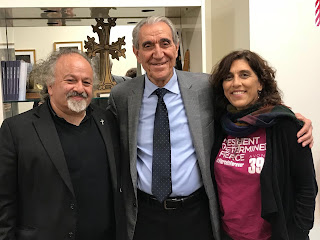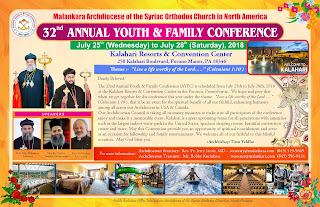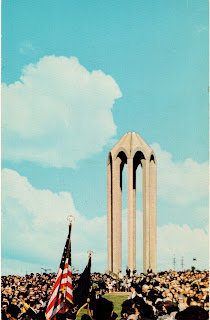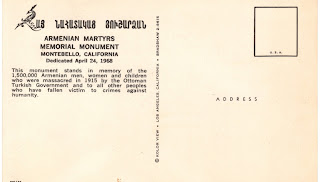A Grand Connection to our Faith: Sunday School Alive
 |
| Piece of the wreckage – shadowbox presented to Fr. Vazken |
“Kahanayk yev joghovort” are the first words of the requiem service of the Armenian Church. The words translate to “the priests and people” referring to a gathering of those who remember the dead in prayer. And there we were, the priest and people, in solemn remembrance of 17 men who perished 60 years ago to the day. I was singing the hymn but this gathering was not in any Armenian church. Far from one, we were standing in the middle of America in Bellevue, Nebraska, near the Offutt Air Force Base. The gathering? Sixty years ago, in the height of the Cold War, a United States Air Force C-130 was shot out of the sky by the Soviet Union. The plane crashed in the village of Nerkin Sasnashen, Armenia (about 60km Northwest of Yerevan).
It was interesting that I sang the hymn in Armenian and no one in the audience understood the language, yet everyone knew very well what was happening. We were connecting as people. We were uniting the remote village of Sasnashen with Bellevue. Armenia was uniting with Nebraska and all of this to attest that a group of men were united with eternity.
 |
| Remembrance in Sasnashen |
Like many Armenians, or many people in general, I had not heard of this shoot-down incident. We grew up in the Cold War fearing the worst, with duck-and-cover drills executed in our school hallways on a regular basis. But who knew that the Cold War was being played out with a shoot-down in Armenia? We should have known for in fact, this major international incident was the most publicized confrontation between the Soviet Union and the U.S. military during the Cold War!
 |
| With the Prop Wash Gang – September 2, 2018, Bellevue, Nebraska |
One of the eye-witnesses to the event was a young man, Martin Kakosian, a college student on a field trip in 1958. Kakosian, a skilled sculptor, later collaborated with the villagers to create a memorial — a khatchkar— honoring an unknown American crew that had died unceremoniously at the edge of their village. In late August 1993, Sasnashen village commemorated the 35th anniversary of the shoot-down during the unveiling of the khachkar.
 |
| With Chief Lonnie Henderson |
 |
| Presentation of the Shadowbox with wreckage |
 |
| Missing Man Table Setting |
Photos courtesy of Pat Morrow.
 |
| Maestro Khoren Mekanejian with Fr. Vazken & Susan at the St. Nersess Armenian Seminary, Armonk, NY 2018 |
 The voice identified himself as a priest of the Indian Orthodox Church, specifically from the Malankara Archdiocese of the Syrian Orthodox Church of North America. “We’ve seen your videos on the Internet and would like to invite you to address our youth at our annual conference.” Of course, “our” videos are “their” videos. The Malankara church is a member of the Oriental Orthodox group of churches and therefore a sister Church of ours. We share a common faith and enjoy communion in our Lord Jesus Christ. As expected, when two siblings find each other the conversation was warm and real. It was a dialogue which landed us in the Poconos Mountains last week for the 32ndAnnual Youth and Family Conference of the Archdiocese.
The voice identified himself as a priest of the Indian Orthodox Church, specifically from the Malankara Archdiocese of the Syrian Orthodox Church of North America. “We’ve seen your videos on the Internet and would like to invite you to address our youth at our annual conference.” Of course, “our” videos are “their” videos. The Malankara church is a member of the Oriental Orthodox group of churches and therefore a sister Church of ours. We share a common faith and enjoy communion in our Lord Jesus Christ. As expected, when two siblings find each other the conversation was warm and real. It was a dialogue which landed us in the Poconos Mountains last week for the 32ndAnnual Youth and Family Conference of the Archdiocese.
| Over 750 Attend the Conference |
Seven hundred and fifty members of the church had travelled from throughout the country to the beauty of the Pennsylvania Mountains to share, worship and grow together with their Primate, His Eminence Mor Titus Yeldho, Archbishop and Patriarchal Vicar. Even more, young and old came together with their clergy for this special week held at the Kalahari Resorts and Convention Center. The excitement level was high. The event had sold-out only a month after reservations began being taken earlier this year!
 |
The comparisons between both our communities – Armenian and Indian – are striking. Issues that we struggle with in the Armenian Church – such as culture and religion, language, assimilation, relevancy – are part of the common conversation. The Indian Orthodox Community, they told me, came to America in the 1970’s, about 70 years after the first Armenian communities were established here. Many of the challenges we encountered during the first few decades of our church’s life in the New World are the ones they feel today. In a very real sense, while speaking to many of the members of their church I felt as if I was looking at the church of our grandparents. We are here in America with new sets of rules and conforming to the societal pressures while trying to remain steadfast to the values and traditions that uniquely define us and give our lives meaning. While in this “time-travel” state I was hoping that reciprocally, in me they would have an opportunity to peer at the church of their grandchildren. There is a lot to learn from each other. While the Armenian Church has been here almost twice as long, ironically it still struggles with the hurdle of language – a hurdle which the Indian community has jumped and, as we witnessed, the youth participate at a very real level of engagement in the liturgies and prayer services.
 |
| Susan during the parade |
 |
| During the Opening Ceremonies |
Those words became my motivation to bring the dimension of outreach and healing to my ministry. And here, a quarter of a century later, I had a chance to share the Gospel message, as it passed through the Armenian people and Armenian Church, to our brothers and sisters in Christ. Personally, this was a very humbling and spiritually rewarding experience.
| Dn. Varoujan & Fr. Vazken Movsesian at Sardarabad |
Los Angeles, California
30 April 2018
It is truly an honor to be offering this homily this evening. I thank His Eminence Archbishop Hovnan Derderian, Primate of the Diocese for giving me this very special honor his evening.
Dreaming and where our dreams CAN lead…
 |
| 1968 postcard: Armenian Genocide Martyrs’ Monument in Montebello, CA |
 |
| Backside of postcard: Armenian Genocide Martyrs’ Monument in Montebello 1968 |
In 1965 I had just turned nine years old when the Armenians in Los Angeles organized a march – 3,000 marchers began at St. Sophia Greek Orthodox Cathedral on Pico and Normandy and ended up at the Ambassador Hotel on Wilshire Blvd. Afterwards the dream was articulated – we needed a place in the Los Angeles area where Armenians could gather and commemorate the Armenian Genocide. In a sense, that Ambassador Hotel on Wilshire was the place where the dream was first dreamt.
Picture: At the end of the service, candles were placed around the small angel which sat quietly throughout the service.
 The Scriptural scene recounted in the Gospel of Mark chapter 7 comes to my mind. A deaf man was brought to Jesus, but along with his restricted hearing the man’s tongue “was tied.” When Jesus healed his hearing, Scripture tells us that “and his tongue was released…” Gaining his hearing was just the beginning of a major change in his life! So much more would now be available to him. Likewise, here in Yerevan, the hearing aids opened the ears of the patients for sure, but even more, now their lives were opened to possibilities for communication, interaction, education, a better life and ultimately to become agents for change in their communities.
The Scriptural scene recounted in the Gospel of Mark chapter 7 comes to my mind. A deaf man was brought to Jesus, but along with his restricted hearing the man’s tongue “was tied.” When Jesus healed his hearing, Scripture tells us that “and his tongue was released…” Gaining his hearing was just the beginning of a major change in his life! So much more would now be available to him. Likewise, here in Yerevan, the hearing aids opened the ears of the patients for sure, but even more, now their lives were opened to possibilities for communication, interaction, education, a better life and ultimately to become agents for change in their communities. The Kavoukjians hosted the Starkey appreciation dinner at Megerian Carpets in Yerevan. Here the Starkey team was treated to some exceptional Armenian food, music, dance and culture. When the Starkey awards were given, they awarded one to the Western Diocese and to the Mother Church of Holy Etchmiadzin. I was honored to pick up these awards on behalf of the Church but after all that we had witnessed over last several days it was obvious that these awards were not necessary. Miracles are a part of Christian life. We witnessed true miracles as people heard, laughed, cried and understood the power of love. We had received our award in the miracles we witnessed. And so, may the awards inspire others to reach out with their resources to help those in need. May we all be encouraged to be a part of the miracle-making that is all around us and that is so necessary in our world today.
The Kavoukjians hosted the Starkey appreciation dinner at Megerian Carpets in Yerevan. Here the Starkey team was treated to some exceptional Armenian food, music, dance and culture. When the Starkey awards were given, they awarded one to the Western Diocese and to the Mother Church of Holy Etchmiadzin. I was honored to pick up these awards on behalf of the Church but after all that we had witnessed over last several days it was obvious that these awards were not necessary. Miracles are a part of Christian life. We witnessed true miracles as people heard, laughed, cried and understood the power of love. We had received our award in the miracles we witnessed. And so, may the awards inspire others to reach out with their resources to help those in need. May we all be encouraged to be a part of the miracle-making that is all around us and that is so necessary in our world today.
At Last, Forever
by Ian Anderson
So why are you holding my hand tonight?
I’m not intending to go far away.
I’m just slipping through to the back room
I’ll leave you messages almost every day.
And who was I to last forever?
I didn’t promise to stay the pace.
Not in this lifetime, babe
But we’ll cling together:
Some kind of heaven written in your face.
So why are you holding my hand tonight?
Well, am I feeling so cold to the touch?
Do my eyes seem to focus
On some distant point?
Why do I find it hard to talk too much?
And who was I to last forever?
I didn’t promise to stay the pace.
Not in this lifetime, babe
But we’ll cling together:
Some kind of heaven written in your face.
So why are you holding my hand tonight?
I’m not intending to go far away.
I’m just slipping through to the back room
I’ll leave you messages almost every day.
And who was I to last forever?
I didn’t promise to stay the pace.
Not in this lifetime, babe
But we’ll cling together:
Some kind of heaven written in your face.
Written by Ian Anderson • Copyright © BMG Rights Management US, LLC
